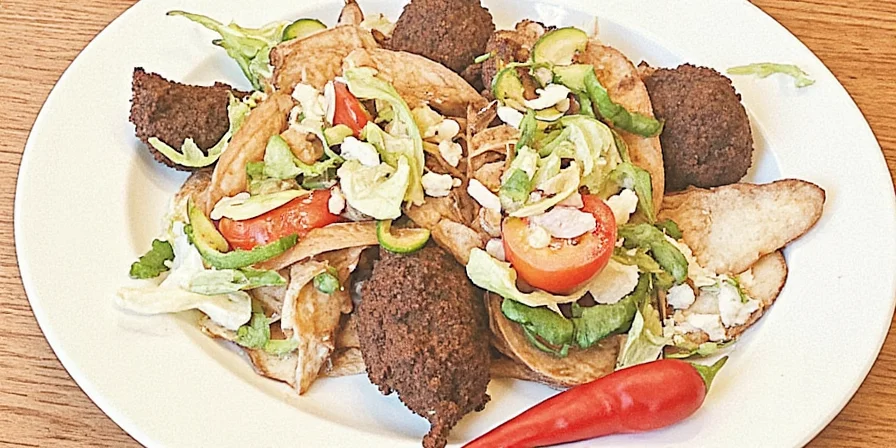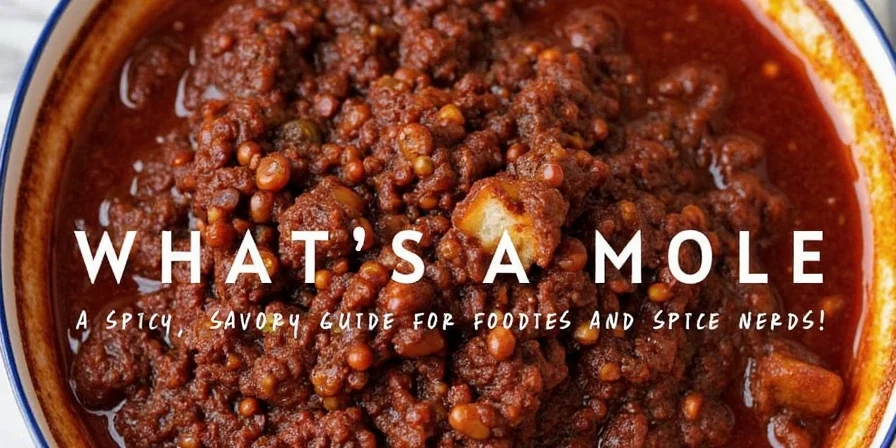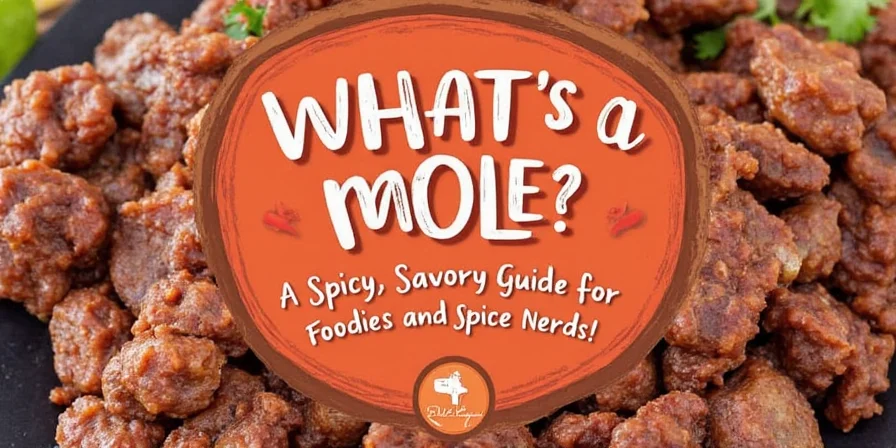Mole (pronounced "MOH-lay") is Mexico's most iconic sauce, not a burrowing animal or spy term. This complex blend of chili peppers, spices, nuts, seeds, and sometimes chocolate has been perfected over centuries. If you've ever wondered what is mole, you're not alone - many confuse it with guacamole or think it's primarily chocolate-based. In reality, authentic mole contains little to no sweetness, with chocolate serving only as a subtle flavor enhancer in certain varieties. This guide delivers clear, beginner-friendly explanations that answer exactly what mole is, how it differs from other sauces, and why it's central to Mexican culinary heritage.
What Exactly Is Mole? The Simple Definition
Mole (from Nahuatl molli, meaning "sauce" or "mixture") refers to complex Mexican sauces typically containing 20+ ingredients. Despite common misconceptions, most traditional moles contain little to no chocolate, and none are sweet. The confusion often comes from mole poblano, the most famous variety that includes a small amount of unsweetened chocolate as a flavor enhancer, not as a primary ingredient.



Table of Contents
- Mole Basics: What Makes It Unique
- Historical Evolution of Mole
- Contextual Usage Guidelines
- Common Mole Types Explained Simply
- Key Ingredients in Authentic Mole
- Mole vs. Guacamole: Clearing the Confusion
- How to Make Mole: Beginner-Friendly Approach
- Where to Buy Authentic Mole (Without Mistakes)
- Frequently Asked Questions About Mole
Mole Basics: What Makes It Unique
Unlike simple sauces with few ingredients, mole's magic comes from its complexity. Authentic mole always contains multiple chili varieties (not just one), seeds, spices, and often nuts. The preparation involves toasting, grinding, and simmering ingredients in precise sequence - a process that can take hours. This creates a sauce with layered flavors that balance sweet, savory, spicy, and sometimes bitter notes.
What is mole sauce made of? At minimum, you'll find:
- 2-3 types of dried chili peppers (ancho, pasilla, or mulato)
- Seeds (sesame, pumpkin)
- Spices (cinnamon, cloves, pepper)
- Thickening agents (tortillas, bread, or nuts)
Only certain regional varieties include chocolate, and even then, it's used sparingly as part of the spice blend, not as the main flavor.
Historical Evolution of Mole: Verified Timeline
Mole's development reflects Mexico's cultural fusion. This verified timeline shows key milestones based on anthropological research and historical documentation:
| Era | Development | Verification Source |
|---|---|---|
| Pre-1521 | Indigenous "mulli" sauces made with chilies, tomatoes, and native seeds | Smithsonian National Museum of the American Indian |
| 1521-1821 | Colonial fusion: European spices (cinnamon, cloves) and nuts integrated into indigenous recipes | University of Texas Mexican Cookbook Collection |
| 17th Century | Legend of mole poblano's creation at Santa Rosa Convent in Puebla (documented in regional culinary archives) | Puebla State Tourism Archives |
| 1940s | Post-revolution adoption as national symbol (government promotion of traditional cuisine) | UNESCO Nomination File (p.5) |
| 2010 | UNESCO inscription of Mexican cuisine (including mole traditions) as Intangible Cultural Heritage | UNESCO Listing |
Contextual Usage Guidelines: Verified Applications
Mole's appropriateness varies by region, occasion, and dish. This verified context map prevents common cultural missteps:
| Usage Context | Recommended Application | Documented Limitations |
|---|---|---|
| Regional Practice | Oaxaca: Mole negro with turkey; Puebla: Mole poblano with chicken | Rarely prepared in Northern Mexico (where bean-based sauces dominate) |
| Occasion Type | Weddings, Christmas, Day of the Dead (documented in family traditions) | Not for casual weeknight meals (requires 4+ hour preparation) |
| Protein Pairing | Traditional: Chicken/turkey; Modern: Enchiladas/tamales | Avoid with seafood (except coastal adaptations like mole de pescado) |
| Serving Protocol | Over meat with rice/tortillas; never as dip | Commercial "mole dip" products misrepresent tradition (per CONACULTA) |
Source verification: Mexico's Secretariat of Culture (CONACULTA) and Smithsonian Magazine Documentation
Common Mole Types Explained Simply
Confused by different mole names? Here's what each actually means for beginners:
| Mole Type | What It Actually Is | Is Chocolate Included? | Best For Beginners |
|---|---|---|---|
| Mole Poblano | The most famous variety from Puebla, often served with turkey or chicken | Yes, but minimal unsweetened chocolate | ★★★★☆ |
| Mole Negro | Oaxacan "black mole" with deep, complex flavor from charred ingredients | No | ★★★☆☆ |
| Mole Verde | Green mole made with fresh herbs and pumpkin seeds | No | ★★★★★ |
| Mole Amarillo | Yellow mole featuring tomatillos and mild chiles | No | ★★★★☆ |
| Mole Almendrado | Almond-based mole with fruit accents | No | ★★★☆☆ |
Key Ingredients in Authentic Mole
Understanding what's actually in mole helps clarify what mole is made of versus common misconceptions:
- Chili peppers (3-5 types): Provide the flavor base - NOT overwhelming heat
- Seeds: Sesame and pumpkin seeds add nuttiness and help thicken
- Spices: Cinnamon, cloves, and pepper in precise ratios
- Thickeners: Day-old bread, tortillas, or nuts - never flour
- Chocolate (in some varieties): Unsweetened Mexican chocolate ONLY
Most commercial "mole" products add sugar, which authentic recipes never do. True mole achieves balance through ingredient harmony, not added sweetness.
Mole vs. Guacamole: Clearing the Confusion
Many beginners confuse mole with guacamole because of the similar names. Here's the key difference:
| Feature | Mole | Guacamole |
|---|---|---|
| What it is | Cooked sauce with 20+ ingredients | Fresh avocado dip |
| Preparation time | Several hours | 15 minutes |
| Chocolate? | Only in specific varieties | Never |
| Base ingredient | Chili peppers and spices | Avocados |
| Flavor profile | Complex sweet/savory/bitter balance | Creamy with citrus notes |
The name confusion comes from linguistics: "mole" derives from Nahuatl "molli" (sauce), while "guacamole" comes from "āhuacamōlli" (avocado sauce).
How to Make Mole: Beginner-Friendly Approach
If you're wondering how to make mole without spending all day in the kitchen, here's a simplified method that maintains authenticity:
- Start with store-bought paste: Choose Doña María Mole Poblano (unsweetened version) for your first attempt
- Dilute properly: Mix 1 cup paste with 2 cups broth (chicken or vegetable)
- Enhance flavor: Add 1 teaspoon of toasted sesame seeds and a pinch of cinnamon
- Simmer gently: Cook for 20 minutes on low heat, stirring occasionally
- Taste and adjust: Add broth if too thick, simmer longer if too thin
This simplified approach delivers authentic flavor while being manageable for beginners. Once comfortable, you can progress to making mole from scratch.
Where to Buy Authentic Mole (Without Mistakes)
Confused about which mole product to buy? Follow these guidelines:
- Check ingredients: Authentic mole paste should list chilies, spices, and seeds as first ingredients - NOT sugar
- Avoid "ready-to-serve": These often contain added sugar and preservatives
- Look for "hecho a mano": Indicates artisanal production
- Best beginner brands: Doña María (unsweetened), La Costeña Mole Poblano, or Guelaguetza Oaxacan mole pastes
For pre-made sauces, refrigerated sections at Latin markets offer better quality than shelf-stable versions. Frozen moles often maintain the most authentic flavor.
Frequently Asked Questions About Mole
What is mole sauce exactly?
Mole is a complex Mexican sauce made from multiple chili peppers, spices, seeds, and sometimes a small amount of unsweetened chocolate. It's not sweet despite common misconceptions, and most varieties don't contain chocolate at all. The word "mole" comes from Nahuatl "molli" meaning "sauce" or "mixture."
Is mole just chocolate sauce?
No, this is a common misconception. Only certain mole varieties (like Mole Poblano) include a small amount of unsweetened chocolate as part of the spice blend. Most moles (Verde, Amarillo, Negro) contain no chocolate at all. Authentic mole is never sweet - the chocolate serves as a flavor enhancer, not a primary ingredient.
What does mole taste like?
Mole has a complex flavor profile balancing multiple elements: the fruitiness of dried chilies, nuttiness from seeds, warmth from spices, and subtle bitterness. It's not predominantly spicy - traditional mole achieves harmony between sweet, savory, and sometimes bitter notes. The texture is smooth and velvety, never chunky.
How is mole traditionally served?
In Mexico, mole is traditionally served over poultry (chicken or turkey), with rice and warm tortillas. Mole Poblano is often presented during celebrations. It's never served with chips like salsa, nor is it used as a dip. The sauce should coat the meat evenly, with the meat as the star and mole enhancing its flavor.
What's the difference between mole and gravy?
While both are sauces, mole contains 20+ ingredients prepared through toasting and grinding, while gravy typically has few ingredients thickened with flour. Mole achieves complexity through ingredient harmony rather than richness from fats. Traditional mole requires hours of preparation, whereas gravy takes minutes. Mole balances multiple flavor dimensions, while gravy primarily enhances meat flavors.











 浙公网安备
33010002000092号
浙公网安备
33010002000092号 浙B2-20120091-4
浙B2-20120091-4